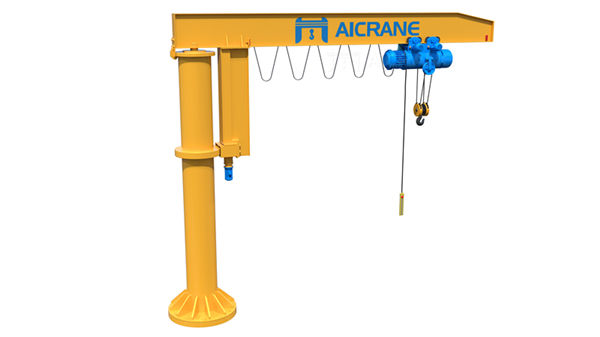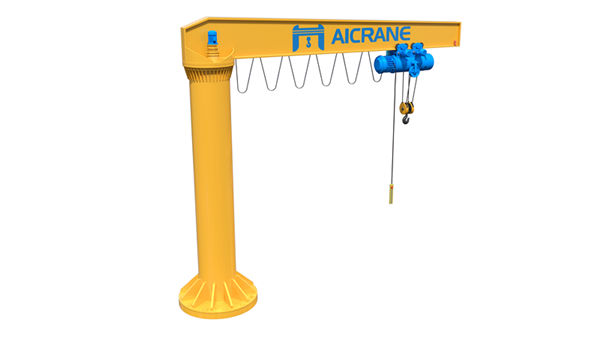Pillar mounted jib crane is used in a variety of ways. These detached cranes are self-supporting, meaning that they aren’t mounted on the wall or on a column of the building. Instead, they are attached to a freestanding pillar that is bolted to the ground.
A jib, which is a horizontal beam, extends out from the top of the pillar, running parallel to the ground. The jib is designed to rotate around the pillar, moving freely in a circular path. Attached to the jib, a special hoist can move from front to back along its entire length. The hoist can be attached to items down below and can then be used to lift them off of the ground.

Cranes like these are commonly installed near workstations. Individual workers use them to assist with heavy lifting tasks. For instance, a worker in charge of assembly may use one of these cranes to lift and move a heavy part so that it can be attached to another piece of the finished product.
Larger pillar-mounted jib cranes are sometimes used outdoors for loading and unloading heavy items from ships. Cranes like these are typically mounted on docks. This allows the jib to swing out over the water and back over the dock, making it easy for it to move items from the boat to the nearby land.
Cranes like these can dramatically reduce strain on workers by reducing the amount of weight that they need to lift during a typical workday. The crane does the heavy lifting for them, meaning they don’t have to strain their backs or overwork their muscles. That means that on-the-job injuries are less likely to occur.

There are several things to consider when choosing a pillar-mounted jib crane. The first consideration is the length of the jib. On average, the span of a typical jib crane is relatively short. However, there are longer lengths available if you need additional coverage. Since these cranes are usually installed close to the workstation or area where they are being used, however, extra-long jibs are rarely required.
The hook height or overhead height of the crane is another important thing to consider. The overall height depends on the amount of clearance that is available in the area where the crane is installed. In buildings with low ceilings, you may need to look for a special model that is designed to work in conditions with very little overhead clearance.
The last thing to think about is the lifting capacity of the crane. Cranes that are designed for workstation applications usually have relatively light lifting capacities. In most cases, that isn’t an issue since the items that are moved in situations like these rarely weigh more than a few tons.
For heavier applications, however, there are sturdier cranes available. The key is to choose a crane that has an adequate lifting capacity for the loads you plan on moving.
Pillar-mounted jib cranes are used for a variety of different applications, ranging from assisting workers at workstations to loading and unloading ships or other vehicles. If you are interested in getting more details on jib cranes and choose a right crane for your business, just click here www.ellsenjibcranes.com/.